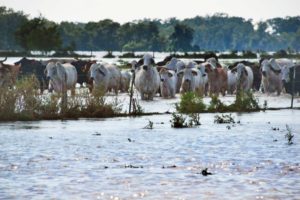In one of the best articles I have read to-date on the costs of Harvey and Irma, from VOX , it is estimated that the damage each storm produced exceeds $100 billion.
Each.
And these are likely to be low-ball numbers.

Two things we can be sure of:
First … storms of this magnitude will happen again. And soon. Maybe as soon as next year. This was the case for Florida, which saw 2017 Irma follow 2016 Matthew. How can cities like Miami, Houston, New Orleans, Key West, and so many others be prepared properly … with such swift turnaround? The short answer is they probably can’t. Cynical as this may sound, grasping that reality is a far better alternative to reacting in the aftermath of hurricane devastation. And hoping heroic efforts will, time and again, carry the day. They won’t.
Second … the hit agriculture takes, and creates — in the form of waste runoff, manure holding pond breaches, etc. — will be among the worst. Animal death tolls will not be available for months and, as of this moment, reasonable figures for environmental damage from agriculture are also unavailable. But this passage (taken from an article on www.agnewsfeed.com, which cites as a source Christopher Collins of the Texas Observer) describes exceptionally well a scene that no doubt was repeated throughout the storm-torn areas of the South and South Central parts of the USA.
“Water never flows here like what we had [during Harvey],” farmer Richie Devillier said. “There was water in some of my pastures where I’ve never seen water before.”
The Devilliers also face a bevy of other flood-related problems, such as property devaluation, stunted grass growth in pastures and the loss of about 1,000 bales of hay that were spirited away from ranches by the rising tide. “We just lost all of it — I could see it floating down the interstate,” Richie said.
Elsewhere in Texas, stories have trickled in of other livestock producers who were walloped by Harvey. In La Grange, about an hour southeast of Austin, ranchers swam to rescue as many cattle as possible after they’d been swept away from properties near Highway 71. A stranded group of cows in Jackson County had to be flushed to higher ground by helicopter. Near Rockport and Ingleside, 100 cattle have been reported dead or missing, along with 120 exotic game animals, including elk and oryx. Those numbers likely will grow as more dead animals are found under piles of debris, said Texas A&M AgriLife extension agent Bobby McCool.
“They’re finding them under the piles as we speak,” said McCool. “They got hung in fences and just got overcome. There’s just quite a few dead in that region.”
The devastation from Harvey and Irma is clear and was seemingly unstoppable. Less obvious in the aftermath is what new precautions can be taken by farmers to minimize problems with farm runoff, while more cleanly managing animals and the manure they create.
